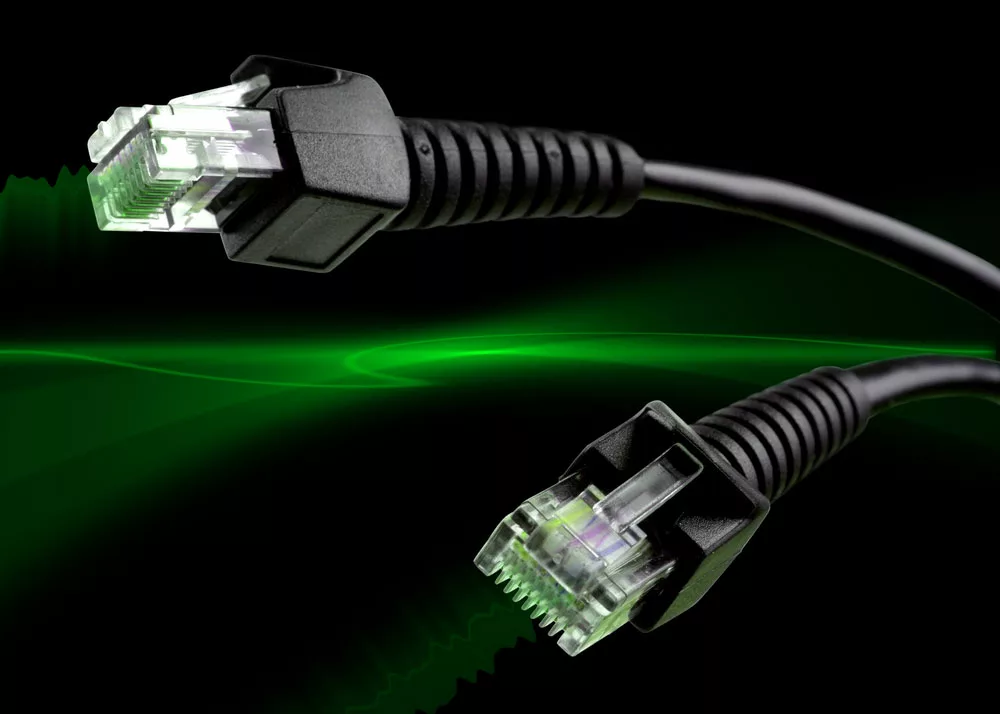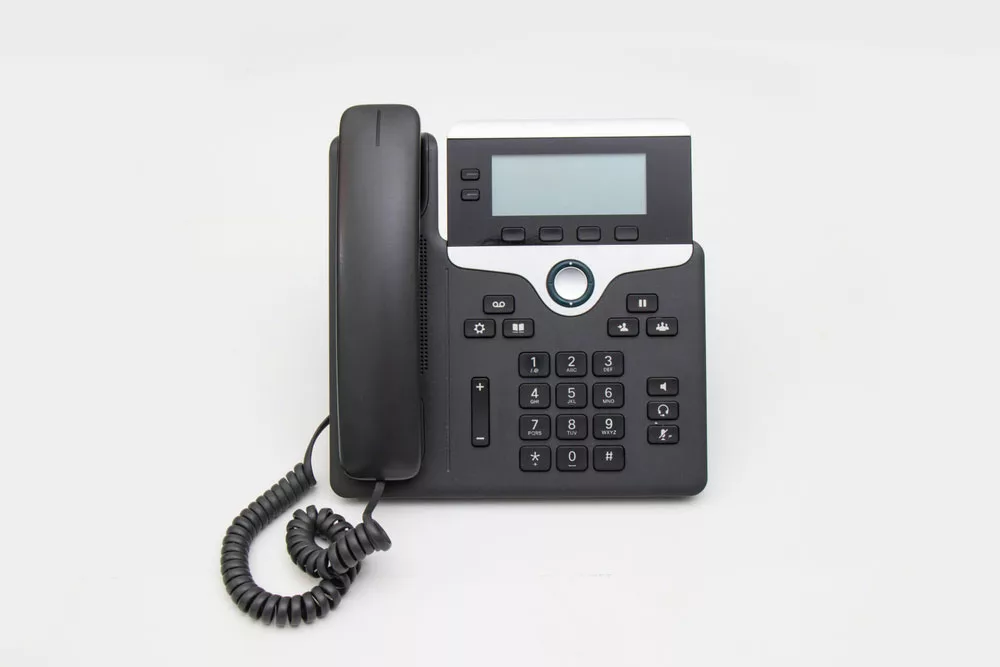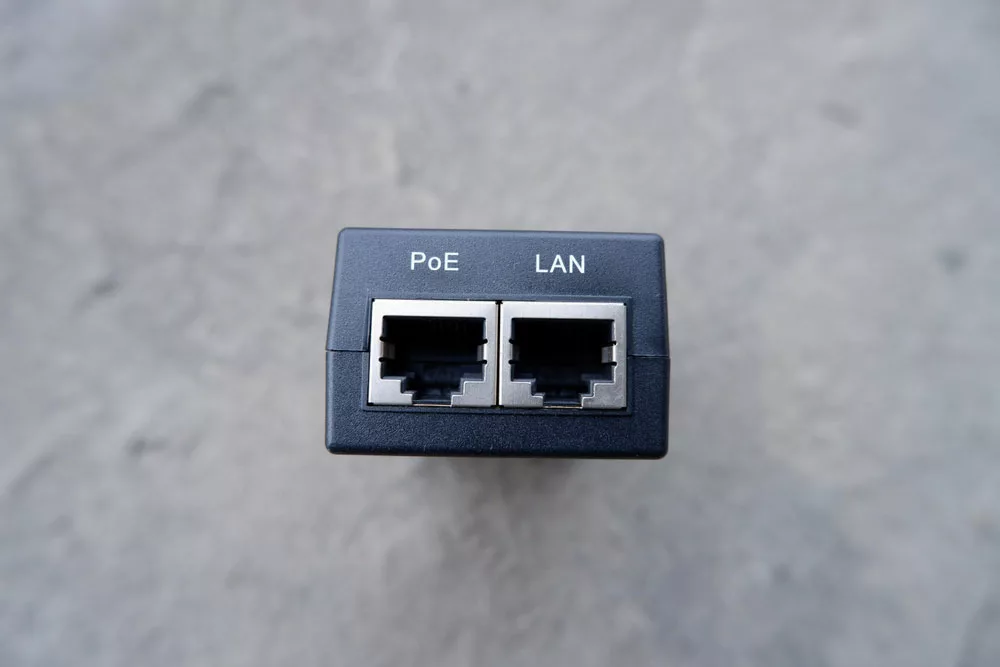Power over Ethernet has become helpful when you cannot access AC power plugs and need to install IP cameras, IP phones, and wireless devices.
If you employ extra power supplies and wiring, it may be too expensive and labor-intensive.
IEEE802.3 established PoE, which delivers lower power voltage to ethernet devices across the communication line.
This article will help you to convert your network safely into PoE.
Table of Contents
- What is PoE or Power over Ethernet?
- How does PoE work, and what is the ethernet cable voltage?
- Can you get a shock with such an ethernet cable voltage?
- Other Safety Measures on Cabling for PoE:
- Conclusion:
What is PoE or Power over Ethernet?
The PoE technology allows electric power transmission over ethernet cable (twisted pair) to different powered devices along with the data. These devices include IP cameras, wireless access points or VoIP phones.
Thus, you do not need an extra cable to pass electric power to the PDs (powered devices).
RJ45 network cable pinout for Power over Ethernet
| RJ45 connector pin | Function | Color T-568A | Color T568-B |
| 1 | Transmitter TX positive | white/green | white/orange |
| 2 | Transmitter TX negative | green | orange |
| 3 | Receiver RX positive | White/orange | white/green |
| 4 | DC positive PoE | Blue | Blue |
| 5 | DC positive PoE | White/Blue | White/Blue |
| 6 | Receiver Rx negative | Orange | Green |
| 7 | DC negative PoE | White/Brown | White/Brown |
| 8 | DC negative PoE | Brown | Brown |

RJ45 network cables for POE
How does PoE work, and what is the ethernet cable voltage?
Ethernet cables such as Cat5e, Cat6, and others have four or eight twisted pair wires. In 10GBASE-T and 100GBASE-T, two pairs send data information, known as data pairs.
The other two remain unused, often referred to as the spare pairs. However, in Gigabit Ethernet, all four pairs help in data transformation.
As you know, electric current always flows in a loop; you need two conductors for electric power transmission.
In PoE technology, each twisted pair acts as a single conductor. Thus, it can use either the two data pairs or spare pairs to carry electric current.
The Power over Ethernet enters the cable between 44-57 volts DC, of which 48 volts is most commonly used.
PoE standards:
Most Power over Ethernet standards allow higher power transmission, broadening the types of devices it can support.
As a result of this, there is a higher adoption of PoE technology in network connections.
PoH or Power over HDBaseT is another standard based on IEEE802.3at, allowing the transmission of audio, video, data signals, and DC power over an ethernet cable for a distance of up to 100 meters or 328 feet.
The amended form of IEEE802.3at is IEEE802.3bt, which allows power transmission for up to 100 watts through a four-pair Cat5e or Cat6 cable.
| PoE power specifications for different standards | ||||
| Specifications | 802.3af PoE | 802.3at PoE+ | 802.3bt 4PPoE | 802.3bt Type 4 |
| Power of device | 12.95watts | 25.5 watts | 51 watts | 71 watts |
| Power supplied | 15.4 watts | 30 watts | 60 watts | 100 watts |
| Voltage of device | 44-57 volts | 50-57 volts | 50-57 volts | 52-57 volts |
| Voltage supplied | 37-57 volts | 42.5-57 volts | 42.5-57 volts | 41.1-57 volts |
| Maximum current | 350 milliamps | 600 milliamps | 600 milliamps | 960 milliamps |
| Resistance | 20 ohms | 12.5 ohms | 12.5 ohms | 12.5 ohms |
| Type of cable | Cat3 and Cat5 | Cat 5 | Cat 5 | Cat5 |
Other cabling standards like ISO and TIA are also updating their standards to support four-pair PoE according to the amended IEEE standard.
TSB-184 guidelines, approved by TIA, allow the implementation of power supplies over balanced ethernet cable.
Also, ISO/IEC 11801-6 international standard specifies Cat6a generic cabling for premises with single or multiple buildings to support IEEE802.3bt 4-pair Power over Ethernet and various other applications.

VoIP phones
Can you get a shock with such an ethernet cable voltage?
Although PoE has enough high voltage to allow efficient power transmission, it is still not too high to shock you.
However, this power can damage devices not designed to get Power over Ethernet.
Thus, PoE must conduct a signature detection process before the switch or PSE/power sourcing equipment allows power transmission to powered devices like IP cameras and others.
Signature detection process understanding
In the signature detection process, a lower voltage passes through the IEEE-compatible powered devices (with 25 kilo-ohms resistance) and detects its characteristic signature.
Once it is identified, PSE can safely apply higher voltages based on the classification.
PSE knows the PD operating power based on the power class if a powered device shows a classification signature.
| PoE power class | 1 | 2 | 3 |
| PSE power available | 4.0 watts | 7.0 watts | 15.4 watts |
| Maximum device power | 3.84 watts | 6.49 watts | 12.95 watts |
The difference in the power given by PSE and power taken by PD is lost as heat in the cable.
If PD does not show any signature during the signature detection process, it is put into class 0 and is given a maximum power of 12.95 watts.
PoE+ devices or Type 2 devices are put into power class 4. If a regular PoE PSE detects this PoE+ device, it will put it into a class 0 device.
However, a PoE+ PSE or 802.3at PSE will identify this device as a PoE+ device and repeat the classification stage to signal the power source to operate at full PoE+ power.
A PoE+ PSE can supply a max. of 30 watts, and the maximum received power by a PoE+ device is 25.5 watts.
Once the PSE detects the signature and classifies the device, it is time to start power transmission. Connect a 48-volt power supply to the power sourcing equipment to enable the working of PD.
Once you switch on the power, the PSE automatically monitors the electric current that a PD should get. In case of too high/too low power, it will cut the power supply, protecting itself from power overload.
How can you add PoE to the network?
You can add a PoE network through three primary methods.
PoE switch: It’s a network switch that injects Power over Ethernet. It links the network devices to the switch and identifies if they are PoE compatible. If yes, they will deliver power automatically.
You can find these switches for a wide range of applications. Thus, there are simple, less-expensive switches with a few ports or complex rack-mounted switches with multiple ports requiring extensive management.
With PSE, you can give PoE functions to a standard network switch. It allows you to update your existing LAN network to PoE.
You can convert each LAN to PoE by simply putting a midspan device. As a result, it becomes a versatile choice in applications requiring fewer ports.
PoE splitter: You can also use a splitter for updating powered deliveries to PoE-capable devices.
The PoE splitter links to the PD network connection and injects power, transforming it to a sufficient level suitable for the camera.

LAN and POE
Other Safety Measures on Cabling for PoE:
As we read above, some power is lost as heat in the ethernet cables transmitting power. Due to this heat, there may be high insertion loss, high power dissipation, and shorter permissible cable lengths.
A cable’s temperature must not exceed its allowable limits. The TIA, or Telecommunications Industry Association, recommends only a 15-degree max allowed rise of temperature over the cable’s ambient temperature in power over cables.
You can lower the cabling temperature in Power over Ethernet applications through the following ways:
Lower the number of cables in a bundle:
Instead of using large or tight bundles, use small cable bundles to reduce the chances of high temperatures in cables significantly.
For instance, a cable bundle with 91 cables has three times higher temperatures than three bundles with 37 cables each. Also, if you separate these three cable bundles physically, it can further reduce the maximum temperature.
Ethernet cable voltage: Pick a high-rated category cable:
High-rated cables have larger gauge sizes; when the temperature rises, the larger conductors of these higher gauge sizes perform better than small gauge cables.
According to TIA, if you use a high-category cable, you can use a large bundle with a maximum of 15 degrees rise in temperature.
The maximum acceptable bundle size for Cat5e is 52 cables, for Cat6 is 64, and for Cat 6a is 74 cables.
Also, a high-rated category cable has a higher current capacity at a maximum of 15 degrees permissible temperature.
Ethernet cable voltage: Avoid copper-clad aluminum for PoE:
Copper-clad aluminum has high DC resistance and thus has less conductivity than pure copper.
As a result, it loses more power, generating more heat. If the cable connection length is longer, the heat generated also rises.
Such high heat and power loss are unsuitable for PoE applications, so avoid them with switches and injectors.
So, it is advisable to use a high-category cable with pure copper conductors to minimize the increase in temperature.
The best is to use Cat6a cable as it supports the highest data throughput in 10GBASE-T.
Also, there are no bundle size restrictions for present and future applications related to PoE.
Conclusion:
You need not worry about electrical shocks from PoE in regular operation and management. They are safe and do not risk your life. However, it is still advisable not to work on the cable while they get power.
Don’t hesitate to call an electrician in case of any faulty electrical connections. Also, always use high-rated cables as they are safe and secure.
Get these high-rated Ethernet cables from a reputed manufacturer like Cloom.
We are a leading cable manufacturer manufacturing and designing custom cable assemblies and wiring harnesses for our clients worldwide.
